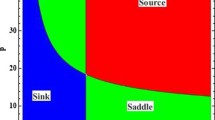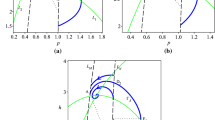Abstract
Plankton and herbivore in aquatic ecosystems are often deeply disturbed by human exploitations in impulsive patterns. In this paper, for a herbivore–plankton interaction model with cannibalism, firstly, the complex dynamic behaviors including the number, the existence and stability of internal equilibriums, the limit and homoclinic cycles, Hopf, saddle node, Pitchfork and Bogdanov–Takens bifurcations are investigated roughly. Furthermore, multiple state feedback controls are implemented so that three order-one periodic solutions (OOPSs) and heteroclinic bifurcation driven by disparate dynamics are induced, respectively. By the method of Bendixson theorem and successor function, the existences of OOPSs are proved. Finally, for the corresponding small parameter-perturbed system, B-convergent of OOPS and homoclinic bifurcation are investigated by the variational equation and the rotated vector, respectively.













Similar content being viewed by others
References
Bainov, D.D., Simeonov, P.S.: Impulsive Differential Equation: Periodic Solutions and Applications. Longman, Harlow (1993)
Busenberg, S., Kumar, S.K., Austin, P., Wake, G.: The dynamics of a model of a plankton–nutrient interaction. Bull. Math. Biol. 52(5), 677–696 (1990)
Chen, L.: Pest control and geometric theory of semi-continuous dynamical system. J. Beihua Univ. 12(1), 9–11 (2011)
Chen, L.: Theory and application of semi-continuous dynamical system. J. Yulin Norm. Univ. 34(2), 1–10 (2013)
Chen, Y.L., Liu, S.A., Tao, S., Zhang, Y.K., Chen, Y.L., Liu, S.A., Tao, S., Zhang, Y.K.: Characteristic analysis of hydraulic hybrid vehicle based on limit cycle. Sci. China Technol. Sci. 55(4), 1031–1036 (2012)
Cheng, H., Wang, F., Zhang, T.: Multi-state dependent impulsive control for holling I predator–prey model. Discrete Dyn. Nat. Soc. 2012(12), 30–44 (2012)
Dai, C., Zhao, M., Chen, L.: Homoclinic bifurcation in semi-continuous dynamic systems. Int. J. Biomath. 5(5), 183–201 (2012)
Daufresne, T., Loreau, M.: Plant–herbivore interactions and ecological stoichiometry: when do herbivores determine plant nutrient limitation. Ecol. Lett. 4(3), 196–206 (2010)
d’Onofrio, A.: On pulse vaccination strategy in the sir epidemic model with vertical transmission. Appl. Math. Lett. 18(7), 729–732 (2005)
Freedman, H.I.: Deterministic mathematical models in population ecology. Biometrics 22(7), 219–236 (1980)
Fu, J., Wang, Y.: The mathematical study of pest management strategy. Discrete Dyn. Nat. Soc. 2012(4), 1–19 (2012)
Guckenheimer, J., Holmes, P.J.: Nonlinear Oscillations, Dynamical Systems, and Bifurcations of Vector Fields. Springer, New York (1983)
Hainzl, J.: Stability and Hopf bifurcation in a predator–prey system with several parameters. Siam J. Appl. Math. 48(1), 170–190 (1988)
Huang, M., Duan, G., Song, X.: A predator-prey system with impulsive state feedback control. Math. Appl. 25(3), 661–666 (2012)
Ivanov, A.P.: Bifurcations in impact systems. Chaos Solitons Fractals 7(10), 1615–1634 (1996)
Jiang, G., Lu, Q., Qian, L.: Complex dynamics of a holling type II preypredator system with state feedback control. Chaos Solitons Fractals 31(2), 448–461 (2007)
Kunkel, P., Kuznetsov, Y.A.: Elements of applied bifurcation theory. Zamm J. Appl. Math. Mech. Z. Angew. Math. Mech. 77(5), 392–392 (1997)
Lehman, J.T.: Release and cycling of nutrients between planktonic algae and herbivores. Limnol. Oceanogr. 25(4), 620–632 (1980)
Leine, R.I., Campen, D.H.V., Vrande, B.L.V.D.: Bifurcations in nonlinear discontinuous systems. Nonlinear Dyn. 23(2), 105–164 (2000)
Lou, J., Lou, Y., Wu, J.: Threshold virus dynamics with impulsive antiretroviral drug effects. J. Math. Biol. 65(4), 623–652 (2012)
Lv, Y., Pei, Y., Gao, S., Li, C.: Harvesting of a phytoplankton–zooplankton model. Nonlinear Anal. Real World Appl. 11(5), 3608–3619 (2010)
Lv, Y., Yuan, R., Pei, Y.: Two types of predator–prey models with harvesting: non-smooth and non-continuous. J. Comput. Appl. Math. 250(10), 122–142 (2013)
Noymeir, I.: Stability of grazing systems: an application of predator–prey graphs. J. Ecol. 63(2), 459 (1975)
Ntr, L., Murray, J.D.: Mathematical biology. I. An introduction. Photosynthetica 40(3), 414–414 (2002)
Pei, Y., Chen, L., Zhang, Q., Li, C.: Extinction and permanence of one-prey multi-predators of holling type II function response system with impulsive biological control. J. Theor. Biol. 235(4), 495 (2005)
Pei, Y., Min, G., Li, C.: A delay digestion process with application in a three-species ecosystem. Commun. Nonlinear Sci. Numer. Simul. 16(11), 4365–4378 (2011)
Shulgin, B., Stone, L., Agur, Z.: Pulse vaccination strategy in the sir epidemic model. Bull. Math. Biol. 60(6), 1123–1148 (1998)
Steele, J.H., Henderson, E.W.: A simple plankton model. Am. Nat. 117(5), 676–691 (1981)
Steele, J.H., Henderson, E.W.: The role of predation in plankton models. J. Plankton Res. 14(1), 157–172 (1992)
Stone, L., Shulgin, B., Agur, Z.: Theoretical examination of the pulse vaccination policy in the sir epidemic model. Math. Comput. Model. Int. J. 31(4–5), 207–215 (2000)
Tang, S., Chen, L.: Modelling and analysis of integrated pest management strategy. Discrete Cont. Dyn. Syst. Ser. B 4(3), 759–768 (2004)
Tang, S., Tang, B., Wang, A., Xiao, Y.: Holling II predator–prey impulsive semi-dynamic model with complex Poincare map. Nonlinear Dyn. 81(3), 1–22 (2015)
Tang, S., Xiao, Y., Cheke, R.A.: Dynamical analysis of plant disease models with cultural control strategies and economic thresholds. Math. Comput. Simul. 80(5), 894–921 (2010)
Tang, S., Xiao, Y., Chen, L., Cheke, R.A.: Integrated pest management models and their dynamical behaviour. Bull. Math. Biol. 67(1), 115–135 (2005)
Tian, Y., Sun, K., Chen, L.: Original article: modelling and qualitative analysis of a predator–prey system with state-dependent impulsive effects. Math. Comput. Simul. 82(2), 318–331 (2011)
Wang, C., Chu, R., Ma, J.: Controlling a Chaotic Resonator by Means of Dynamic Track Control. Wiley, New York (2015)
Wei, C., Chen, L.: Heteroclinic bifurcations of a prey–predator fishery model with impulsive harvesting. Int. J. Biomath. 6(6), 85–99 (2013)
Wei, C., Chen, L.: Homoclinic bifurcation of prey–predator model with impulsive state feedback control. Appl. Math. Comput. 237(7), 282–292 (2014)
Xiao, Y., Miao, H., Tang, S., Wu, H.: Modeling antiretroviral drug responses for HIV-1 infected patients using differential equation models. Adv. Drug Deliv. Rev. 65(7), 940–953 (2013)
Xiao, Y., Xu, X., Tang, S.: Sliding mode control of outbreaks of emerging infectious diseases. Bull. Math. Biol. 74(10), 2403–2422 (2012)
Yang, Y., Xiao, Y.: Threshold dynamics for compartmental epidemic models with impulses. Nonlinear Anal. Real World Appl. 13(1), 224–234 (2012)
Tian, Y., Sun, K., Chen, L.: Geometric approach to the stability analysis of the periodic solution in a semi-continuous dynamic system. Int. J. Biomath. 7(2), 121–139 (2014)
Zeng, G., Chen, L., Sun, L.: Existence of periodic solution of order one of planar impulsive autonomous system. J. Comput. Appl. Math. 186(2), 466–481 (2006)
Zhang, M., Song, G., Chen, L.: A state feedback impulse model for computer worm control. Nonlinear Dyn. 85(3), 1–9 (2016)
Zhao, L., Chen, L., Zhang, Q.: The geometrical analysis of a predator–prey model with two state impulses. Math. Biosci. 238(2), 55–64 (2012)
Acknowledgements
The authors would like to appreciate the editors and the reviewers for their constructive and helpful comments. The work is supported by the National Natural Science Foundation of China (11471243, 11501409, 11671346).
Author information
Authors and Affiliations
Corresponding author
Additional information
The work was supported by the National Natural Science Foundation of China (11471243).
Rights and permissions
About this article
Cite this article
Fang, D., Pei, Y., Lv, Y. et al. Periodicity induced by state feedback controls and driven by disparate dynamics of a herbivore–plankton model with cannibalism. Nonlinear Dyn 90, 2657–2672 (2017). https://doi.org/10.1007/s11071-017-3829-y
Received:
Accepted:
Published:
Issue Date:
DOI: https://doi.org/10.1007/s11071-017-3829-y




